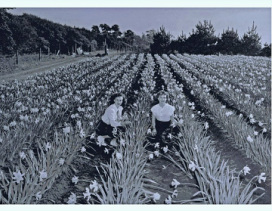Farming

The early lure of Humboldt County was not entirely its gold and lumber. Attracted by the year-round mild climate, many early settlers went into farming. Grains and vegetables such as potatoes were among the early successful crops.
Livestock soon grew in importance. Sheep and cattle did particularly well in the hilly coastal country and east of the redwood belt. Small cattle ranches were part of the early Humboldt scene, and many continue today. The cool climate and rich pasturage produced sheep with desirable long-fibered wool, and a woolen mill thrived in Eureka for over fifty years. Sheep raising declined with the increased use of man-made fibers.
In parts of the county, dairy farming became preeminent. Drained marshlands around Humboldt Bay supported a number of dairy farms. So did cleared valley bottoms, particularly once new grasses were introduced in the 1880s. In the 20th century, dairy co-operatives took over most of the processing operations, and dairy products such as cheese, butter and powdered milk became important area exports.
From early on, Humboldt County was known for the variety and quality of its fruit. Pears, plums, peaches and berries did well, but apples were considered "king" and were a major export. Barged down the Eel River from the Mattole Valley, apples were shipped by the barrelful to San Francisco.
In the late 19th and early 20th centuries, political troubles in Europe sent waves of immigrants to America. Danes, Italians, Portuguese and Croatians were among those settling in Humboldt County - bringing cultural diversity and farming expertise. They formed social organizations to help retain their cultural identity.
Livestock soon grew in importance. Sheep and cattle did particularly well in the hilly coastal country and east of the redwood belt. Small cattle ranches were part of the early Humboldt scene, and many continue today. The cool climate and rich pasturage produced sheep with desirable long-fibered wool, and a woolen mill thrived in Eureka for over fifty years. Sheep raising declined with the increased use of man-made fibers.
In parts of the county, dairy farming became preeminent. Drained marshlands around Humboldt Bay supported a number of dairy farms. So did cleared valley bottoms, particularly once new grasses were introduced in the 1880s. In the 20th century, dairy co-operatives took over most of the processing operations, and dairy products such as cheese, butter and powdered milk became important area exports.
From early on, Humboldt County was known for the variety and quality of its fruit. Pears, plums, peaches and berries did well, but apples were considered "king" and were a major export. Barged down the Eel River from the Mattole Valley, apples were shipped by the barrelful to San Francisco.
In the late 19th and early 20th centuries, political troubles in Europe sent waves of immigrants to America. Danes, Italians, Portuguese and Croatians were among those settling in Humboldt County - bringing cultural diversity and farming expertise. They formed social organizations to help retain their cultural identity.
